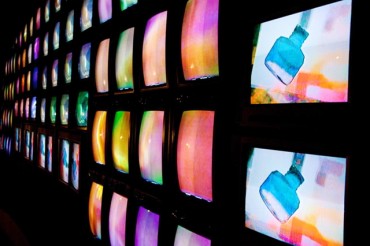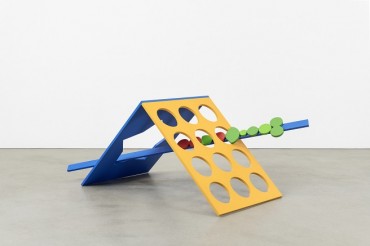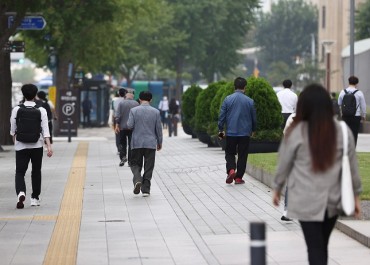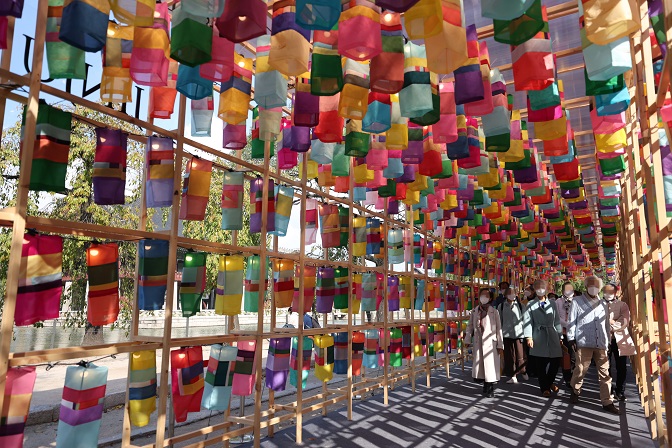
Visitors look at displays at Gyeongbok Palace in central Seoul on Oct. 19, 2021, as the Royal Culture Festival 2021 is underway at palaces from Oct. 16-31. (Yonhap)
SEOUL, Oct. 20 (Korea Bizwire) — On a sunny autumn afternoon, hundreds of traditional Korean lanterns with silk shades of all different colors fluttered gently in the breeze at a courtyard of the Gyeongbok Palace in central Seoul.
Visitors wearing masks to prevent the spread of the coronavirus busily took photos of themselves against the backdrop of a tunnel made up of about 1,500 lanterns with silk shades from Jinju, 434 kilometers south of Seoul.
The 28-meter tunnel was among the art projects featured in an outdoor exhibition underway at the main palace of the Joseon Dynasty (1392-1910).
The exhibition, titled “Daedongyejido,” opened Saturday as part of the Royal Culture Festival 2021, co-hosted by the Cultural Heritage Administration and the Korea Cultural Heritage Foundation.
The title is a compound of “Daedongyeojido,” a famous map from the Joseon era, and the word “ye,” meaning art.
On display at seven makeshift outdoor exhibition halls are cultural heritage items or specialties representing seven provincial cities, including the traditional paper of “hanji” from Wonju, porcelain from Icheon, natural dyeing culture from Naju, bamboo from Damyang and tea from Boseong.
“There were demands from local governments to participate in the annual festival,” Joo Jay-youn, artistic director of the festival, said during a press tour of the exhibition on Tuesday. “This is a modest exhibition decorated with local specialties suitable for palaces.”
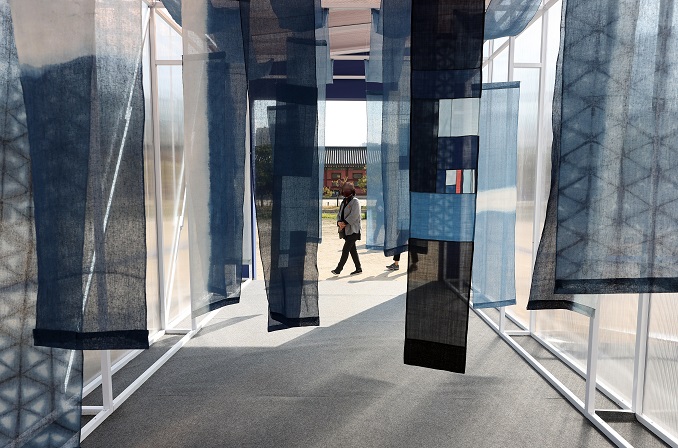
Visitors look at displays at Gyeongbok Palace in central Seoul on Oct. 19, 2021, as the Royal Culture Festival 2021 is underway at palaces from Oct. 16-31. (Yonhap)
The tour began at an exhibition hall set up in front of Geunjeong Gate to display natural dyeing culture of Naju, South Jeolla Province.
About 130 all bluish artworks and various living items such as traditional Korean curtains, umbrellas, eco bags, cushions and masks made by 11 artists, including Youn Young-sook, from naturally dyed indigo fabric caught eyes of visitors.
There are six more exhibition spots after passing through the gate and turning left from Geunjeong Pavillion.
The first thing you see when you walk in is “moon jars,” a type of traditional round and large white porcelain vase that looks like a full moon.
More than 130 vases made by Shin Chul, a ceramic artist known for making white porcelain vases in a traditional way, sit on the lawn in front of Sujeong Pavillion located south of a man-made pond.
Also among the highlights of the exhibition is a booth for exhibiting hanji papers from Wonju, Gangwon Province.
A tunnel of “flower rain,” an installation work made of thousands of hanging paper flowers of red, yellow, pink and blue, visitors can see a unique and elegant chandelier and a mobile, also made of hanji.
“Many local festivals have been canceled due to the coronavirus pandemic, which is sad,” Yoo Kwan-sook, exhibition director, said during the press tour. “So we hope people residing in Seoul can experience unique culture from provincial areas through this exhibition.”
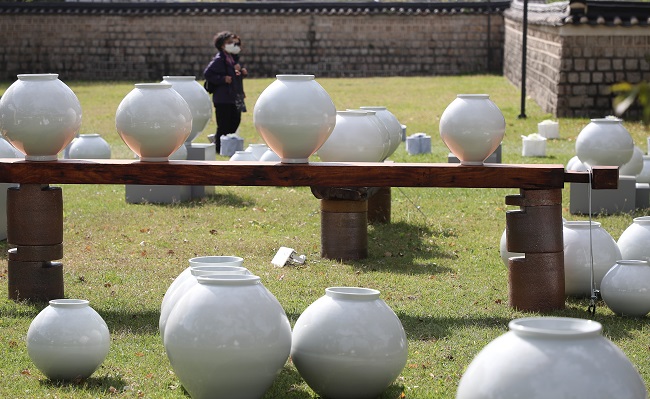
Visitors look at displays at Gyeongbok Palace in central Seoul on Oct. 18, 2021, as the Royal Culture Festival 2021 is underway at palaces from Oct. 16-31. (Yonhap)
Organizers said visitors can better enjoy some exhibits, such as a tunnel of silk lanterns and white porcelain vases, when they visit at night, but nighttime viewing is available by online reservation only.
A maximum of 120 people per day can join the program due to COVID-19 restrictions.
The special nighttime tour is set to end Wednesday, but those who don’t want to miss the chance of viewing the exhibits with subtle lighting can use the palace’s separate autumn-seasonal nighttime sightseeing program that begins Thursday.
The palace will open from 7 p.m. to 9:30 p.m. till Nov. 29 under the program, so participants can enjoy the exhibition at night until it closes Sunday.
Even after the exhibition’s closure, the festival is scheduled to run online till Oct. 31.
Nine programs, such as a palace-themed music performance by five teams of artists, a video of a dance drama with elements of theater musical are available on the festival’s official social media accounts and YouTube channel.
(Yonhap)



